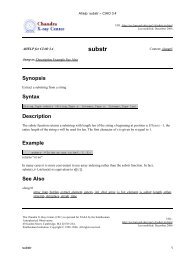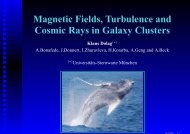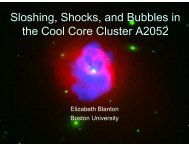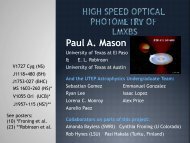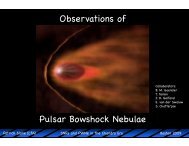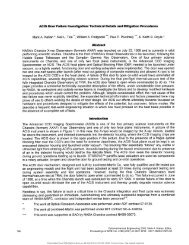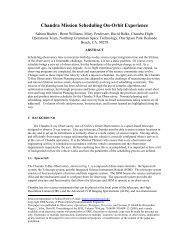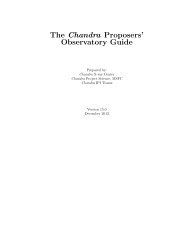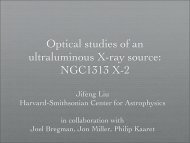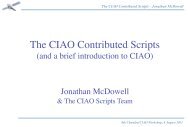PDF Version - Chandra X-Ray Observatory (CXC)
PDF Version - Chandra X-Ray Observatory (CXC)
PDF Version - Chandra X-Ray Observatory (CXC)
Create successful ePaper yourself
Turn your PDF publications into a flip-book with our unique Google optimized e-Paper software.
Spring, 2012<br />
<strong>Chandra</strong> data processing and distribution to observers<br />
continued smoothly, with the average time from<br />
observation to delivery of data averaging roughly 30 hours.<br />
The <strong>Chandra</strong> archive holdings grew by 0.5 TB to 8.8 TB<br />
and now contain 32.7 million files. <strong>Chandra</strong> Source Catalog<br />
data products represent 1.8 TB of the archive.<br />
The Data System team released software updates to<br />
support the submission deadline for Cycle 13 observations<br />
proposals (March 2011), the Cycle 13 Peer Review (June)<br />
and the Cycle 14 Call for Proposals (December 2011). Software<br />
upgrades supported the multi-cycle observing proposals<br />
that were solicited beginning in Cycle 13.<br />
In addition, several enhancements to instrument<br />
algorithms have been incorporated into standard data<br />
processing and also released in CIAO 4.4 (December),<br />
including a new ACIS afterglow/hot pixel determination<br />
tool. Work is progressing on a new version of the <strong>Chandra</strong><br />
Source Catalog (CSC) that will increase the number of<br />
detected X-ray sources. The new CSC version will extend<br />
the catalog to fainter limits by combining multiple observations<br />
and by using new algorithms to allow point sources as<br />
faint as ~5 counts to be detected on-axis, resulting in a ~2.5<br />
times increase in the number of X-ray sources included in<br />
the catalog.<br />
The <strong>CXC</strong> Education and Public Outreach (EPO)<br />
group in 2011 created 15 science press releases, a press release<br />
posting and 12 image releases, and produced 22 60<br />
second High Definition podcasts on astrophysics and <strong>Chandra</strong><br />
results. Two of the group’s animated videos earned platinum-level<br />
Pixie awards from the American Pixel Academy.<br />
<strong>CXC</strong> staff created 75 blog entries, and initiated live tweets<br />
from such venues as the AAS meeting, science fairs and the<br />
NASA press conference.<br />
EPO personnel presented 26 workshops at conferences<br />
and clinics sponsored by the National Science Teacher<br />
Association, National Science Olympiad, American Association<br />
of Physics Teachers, and the Astronomy Society<br />
of the Pacific. EPO staff presented an invited talk on public<br />
science at the October conference Communicating Astronomy<br />
with the Public, sponsored by the International Astronomical<br />
Union.<br />
The EPO group was awarded a grant to support<br />
NASA’s Year of the Solar System initiative by developing<br />
the exhibit From Earth to the Solar System, modeled on the<br />
EPO-created exhibit From Earth to the Universe (FETTU).<br />
The Braille panels developed for FETTU were donated to<br />
the National Federation for the Blind for permanent exhibit<br />
at its Jernigan Institute.<br />
We look forward to a new year of continued smooth<br />
operations and exciting science results. Please join us for<br />
the workshop “X-ray Binaries, 50 Years Since the Discovery<br />
of Sco X-1”, to be held in Boston July 10–12, 2012.<br />
Important Dates for<br />
<strong>Chandra</strong><br />
Cycle 14 Peer Review: June 25–29, 2012<br />
Workshop: July 10–12, 2012<br />
50 Years of X-ray Binaries<br />
Cycle 13 Cost Proposals Due: Fall 2012<br />
Users’ Committee Meeting: October, 2012<br />
Einstein Fellows Symposium: Fall 2012<br />
Cycle 14 Start: December, 2012<br />
Cycle 15 Call for Proposals: December, 2012<br />
ACIS Update<br />
Paul Plucinsky, Royce Buehler, Nancy<br />
Adams-Wolk, & Gregg Germain<br />
The ACIS instrument continued to perform well over the<br />
past year with no anomalies or unexpected degradations.<br />
The charge-transfer inefficiency (CTI) of the FI and BI<br />
CCDs is increasing at the expected rate. The contamination<br />
layer continues to accumulate on the ACIS optical-blocking<br />
filter. Recent data indicate that the contaminant may<br />
be increasing in thickness faster than the current model<br />
predicts, especially around the edges of the filter which are<br />
colder than the center of the filter. The <strong>CXC</strong> calibration<br />
group is analyzing the data and may produce an updated<br />
contaminant model in the coming year.<br />
The control of the ACIS focal plane (FP) temperature<br />
continues to be a major focus of the ACIS Operations<br />
Team. As the <strong>Chandra</strong> thermal environment continues to<br />
evolve over the mission, some of the components in the<br />
Science Instrument Module (SIM) close to ACIS have been<br />
reaching higher temperatures, making it more difficult to<br />
maintain the desired operating temperature of -119.7° C at<br />
9



